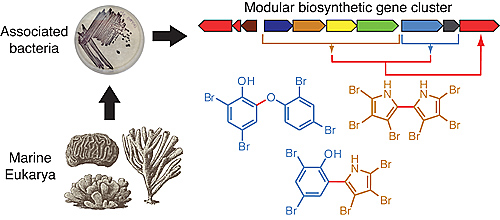Marine Bacteria Are Natural Source of Chemical Fire Retardants
Published Date
By:
- Scott LaFee
Share This:
Article Content
Researchers at the University of California, San Diego School of Medicine have discovered a widely distributed group of marine bacteria that produce compounds nearly identical to toxic man-made fire retardants.

Some marine bacteria produce potent persistent organic compounds that are nearly identical to flame retardent chemicals.
Among the chemicals produced by the ocean-dwelling microbes, which have been found in habitats as diverse as sea grasses, marine sediments and corals, is a potent endocrine disruptor that mimics the human body's most active thyroid hormone.
The study is published in the June 29 online issue of Nature Chemical Biology.
"We find it very surprising and a tad alarming that flame retardant-like chemicals are biologically synthesized by common bacteria in the marine environment," said senior author Bradley Moore, PhD, a professor at the UC San Diego Skaggs School of Pharmacy and Pharmaceutical Sciences and Scripps Institution of Oceanography.
The toxic compounds are known as polybrominated diphenyl ethers (PBDEs), a subgroup of brominated flame retardants that are combined into foam, textiles and electronics to raise the temperature at which the products will burn.
Certain formulations of PBDEs are no longer used in automobile and home products in the United States, but testing by the Environmental Protection Agency indicates that most Americans and Canadians carry traces of the chemicals. Indeed, levels exceed those of Europeans and others by a factor of ten or more. Californians, in particular, have higher than average “body burdens” of the compounds.
Although the presence, persistence and ability of PBDEs to accumulate in the fatty tissues of marine animals have long been recognized, researchers had previously believed the compounds were anthropogenic in origin and due to ocean pollution.
More recent examinations have shown a pervasiveness of PBDEs in prey and predatory species, suggesting a natural microbial source of the compounds as well as an anthropogenic one.
The study is the first to isolate and identify bacteria that synthesize these compounds and whose presence may help explain the observed distribution pattern of PBDEs in the marine food chain.
In the study, the researchers identified a group of ten genes involved in the synthesis of more than 15 bromine-containing polyaromatic compounds, including some PBDEs. They have since conducted DNA sequencing analyses that will allow them to probe the ocean for other biological sources for these chemicals and to begin to assemble a complete picture of their human health risk.
“The next step is to look more broadly in the marine environment for the distribution of this gene signature and to document how these compounds are entering the food chain,” said Vinayak Agarwal, PhD, a postdoctoral researcher with the Scripps Center for Oceans and Human Health at UC San Diego.
Co-authors include Abrahim El Gamal, Kazuya Yamanaka, Roland Kersten, Dennis Poth, Michelle Schorn, and Eric Allen, all at UCSD.
Funding for this study was provided, in part, by the National Science Foundation (grant OCE-1313747) and National Institute of Environmental Health Sciences (grant P01-ES021921) through its Oceans and Human Health program.
Share This:
Stay in the Know
Keep up with all the latest from UC San Diego. Subscribe to the newsletter today.



